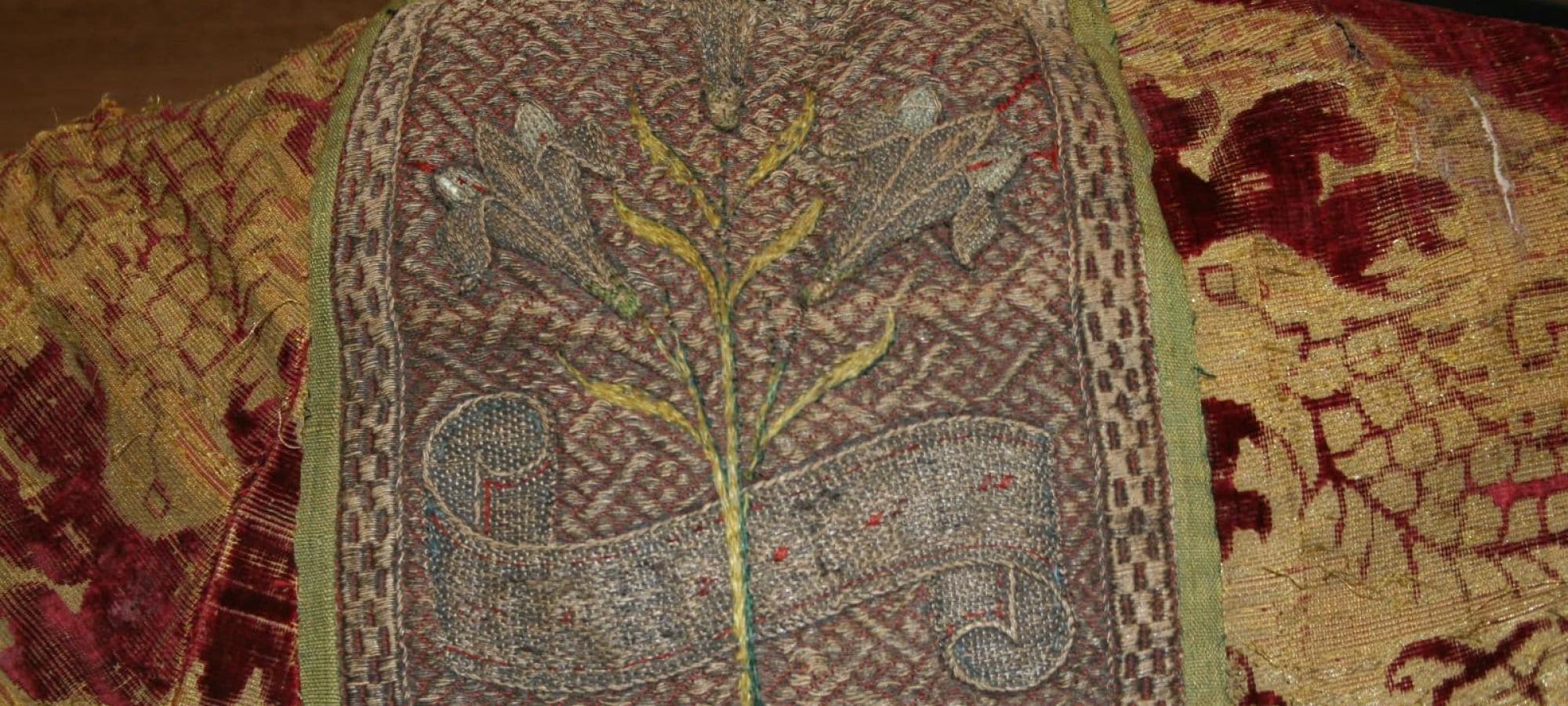
The History of the English Reformation in One Vestment
Editor's Note: We're grateful to the Campion Hall Archival Associate Altair Brandon-Salmon for the following essay telling of one of the Hall's more historically significant treasures.
The history of this rare late medieval, English vestment held by Campion Hall symbolises the whole process of the English Reformation, its provenance speaking to Catholic England, the Reformation, and recusant Catholics still practicing their religion. The unusual iconography of the flowering lily emerging from the Cross on the reverse of the vestment offers a unique insight into the visual culture of Catholic England which was subsequently repressed and, to a considerable extent, erased.
The iconography of the Lily Crucifixion
The motif of the Lily Crucifixion seen on the back of this priest's vestment, was common in medieval England. Examples are found in stained glass at St. Michael's at the North Gate, Oxford, and at Long Melford Church, Suffolk. One of the earliest instances is from Wales, a late 14th century Llanbeblig Book of Hours, where a vase of lillies shaped as a crucifix is placed next to the Virgin Mary at the Annunciation. The Lily Crucifix appears on an early 16th century altar frontal from Sawston Hall, Cambridgeshire, and at Godshill, on the Isle of Wight, the church has a wallpainting of Christ crucified, the cross substituted by a lily.
The iconography of the lily crucifixion was widespread across England and almost unique to the country, with only a few minor examples found in Europe. All the surviving examples date from between the 14th and 16th centuries, ending with the Reformation. The introduction of a lily into the crucifixion varies widely, indicating little about a common origin beyond the iconography itself. However, most deployments of the motif were in media like stained glass or vestments, meant to be seen by the congregation. Campion Hall's lily vestment is restrained in comparison to other versions, with a small three-headed lily (in reference to the Trinity) emerging from the head of the cross. Particularly when depicted in stained glass, it was common to replace the entire cross with the lily.
The meaning of the iconography is not wholly clear, but it seems related to the medieval belief that Christ was crucified on the same day as the Annunciation, 25th March. The lily symbolised both the joy of the Annunciation and the grief of Christ's crucifixion. The lily united in a single image both the beginning and end of Christ's life on earth.
Good Friday and the Annunciation fall on 25th March a number of times every century and it was believed that it was an inauspicious occasion in medieval England. John Donne described it thus, slightly later in 1608:
Of feast or fast, Christ came and went away;
(Upon the Annunciation and Passion Falling upon One Day)
The symbol of the lily crucifix would have had increased resonance on these days, possibly believed to protect the Church and the community, in the light of a popular belief that these coincidences in the calendar were unlucky days for England. As a consequence, the Lily Crucifix is seen in the most public parts of church, on stained glass, altar frontals, and with Campion Hall's example, a priest's vestment. The Reformation ended this distinctively English Catholic iconography, but its geographical dispersal across the country indicates that it was well-known and commonly seen in medieval churches.
The orphreys on the chasuble are English work of the 15th century, with the vestment showing traces of at least two campaigns of repair. The iconography of the Lily Crucifixion confirms its English origins. It appears possible that it was once two separate vestments—the East Anglian saints and the Crucifixion belonging to different vestments—which were subsequently combined.
The first repairs of the vestment, were probably undertaken in the mid 16th century, and consisted of reusing the severely damaged opus anglicanum figure of a Saint-King, possibly Edward the Confessor, on the front orphrey, and the addition of a continental silk figure of perhaps St. John. The very damaged state of the Saint-King, suggests that few options were open to the repairer, perhaps working in haste during the reign of Queen Mary.
The second wave of interventions saw the orphreys applied to a fiddle-back chasuble, on high quality gold brocade, probably reclaimed from another vestment. This likely dates from the penal times, perhaps the work of a recusant family still practicing their faith, but with limited means of doing so.
The tortured history of this vestment tells in itself the history of the English Reformation: from its beginnings as two opus anlicanum vestments, one with the lily crucifix, the other with the East Anglian saints, to a repair, possibly during Queen Mary's reign, and a final re-laying in circumstances of recusant constraint. Three hundred years of ecclesiastical history are visible within this one vestment.
Bibliography
Cristina Maria Cervone, Poetics of the Incarnation: Middle English Writing and the Leap of Love (Philadelphia: University of Pennsylvania Press, 2012).
John Edwards, 'Lily-Crucifixions in the Oxford District', in Oxford Art Journal, Vol. 2, Art and Society (Apr., 1979), pp. 43-45.
W.L. Hildburgh, FSA, 'Some further Notes on the Crucifix on the Lily', in The Antiquaries Journal, Vol. XII (January, 1932), No. 1, pp. 24-6.
Long Melford Church, Suffolk: www.english.cam.ac.uk/medieval/zoomtest.php?id=522 (accessed: 23/5/17)
Sawston Hall altar frontal: http://www.mallams.co.uk/news/early-altar-frontals/ (accessed: 23/5/17)
Godshill wallpainting: http://www.paintedchurch.org/godshill.htm (accessed: 23/5/17)

